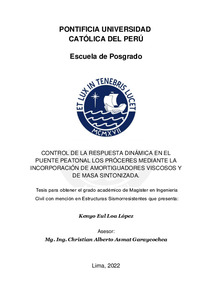| dc.contributor.advisor | Asmat Garaycochea, Christian Alberto | |
| dc.contributor.author | Loa López, Kenyo Eul | |
| dc.date.accessioned | 2022-07-05T17:51:00Z | |
| dc.date.available | 2022-07-05T17:51:00Z | |
| dc.date.created | 2022 | |
| dc.date.issued | 2022-07-05 | |
| dc.identifier.uri | http://hdl.handle.net/20.500.12404/22732 | |
| dc.description.abstract | Las mejoras continuas de la ingeniería de materiales nos permiten diseñar cada vez
puentes más ligeros y de mayor longitud. Sin embargo, a pesar de que los puentes
peatonales pueden cumplir los estados de carga de servicio o resistencia, la normativa
peruana no contempla una revisión de la respuesta vibratoria de los puentes peatonales
bajo cargas de servicio. Esto ocasiona que muchas veces se tienen problemas de
vibración una vez entren en funcionamiento. Mucho menos existen normas o criterios
en caso este tipo de problemas se presenten. Así se tiene la presente investigación la
cual empieza con una revisión del estado del arte sobre vibración de puentes
peatonales. Luego se hace una un levantamiento de la estructura en campo que
permitan obtener los datos suficientes para modelar la estructura y obtener sus
propiedades dinámicas basados en un software de elementos finitos. Posteriormente se
propone el control de las vibraciones incorporando amortiguadores de masa y como
segunda alternativa usando amortiguadores viscosos. A partir de ambos diseños y los
datos obtenidos se comparará la respuesta de ambas propuestas. | es_ES |
| dc.description.abstract | Continuous improvements in materials engineering allow us to design ever lighter and
longer bridges. However, despite the fact that pedestrian bridges can comply with the
service load or resistance states, Peruvian regulations do not contemplate a review of
the vibration response of pedestrian bridges under service loads. This causes that many
times there are vibration problems once they are in operation. Much less are there rules
or criteria in case this type of problem arises. Thus, we have the present investigation
which begins with a review of the state of the art on vibration of pedestrian bridges. Then
a survey of the structure is made in the field to obtain sufficient data to model the
structure and obtain its dynamic properties based on finite element software.
Subsequently, the control of vibrations is proposed incorporating mass dampers and as
a second alternative using viscous dampers. From both designs and the data obtained,
the response of both proposals will be compared. | es_ES |
| dc.language.iso | spa | es_ES |
| dc.publisher | Pontificia Universidad Católica del Perú | es_ES |
| dc.rights | info:eu-repo/semantics/openAccess | es_ES |
| dc.rights.uri | http://creativecommons.org/licenses/by-nc-sa/2.5/pe/ | * |
| dc.subject | Puentes--Vibración | es_ES |
| dc.subject | Puentes--Dinámica | es_ES |
| dc.subject | Puentes para peatones--Amortiguación | es_ES |
| dc.title | Control de la respuesta dinámica en el puente peatonal Los Próceres mediante la incorporación de amortiguadores viscosos y de masa sintonizada | es_ES |
| dc.type | info:eu-repo/semantics/masterThesis | es_ES |
| thesis.degree.name | Maestro en Ingeniería Civil con mención en Estructuras Sismorresistentes | es_ES |
| thesis.degree.level | Maestría | es_ES |
| thesis.degree.grantor | Pontificia Universidad Católica del Perú. Escuela de Posgrado | es_ES |
| thesis.degree.discipline | Ingeniería Civil con mención en Estructuras Sismorresistentes | es_ES |
| renati.advisor.dni | 45650009 | |
| renati.advisor.orcid | https://orcid.org/0000-0003-3893-4573 | es_ES |
| renati.author.dni | 47110436 | |
| renati.discipline | 732317 | es_ES |
| renati.juror | Santos Cavalho, Dennis Jesus | es_ES |
| renati.juror | Asmat Garaycochea, Christian Alberto | es_ES |
| renati.juror | Zeballos Cabrera, Antonio | es_ES |
| renati.level | https://purl.org/pe-repo/renati/level#maestro | es_ES |
| renati.type | https://purl.org/pe-repo/renati/type#tesis | es_ES |
| dc.publisher.country | PE | es_ES |
| dc.subject.ocde | https://purl.org/pe-repo/ocde/ford#2.01.01 | es_ES |






